Spring 2018 Design Projects
Projects
- Alternative Method to Press a Sewing Machine Foot Pedal
- Development of a Bathtub lift
- Device to Assist in using a toilet
- Beach Wheelchair
- Restoration of a Pratt & Whitney R-4360 Aircraft Engine
- Analysis and Improvement of a Motorcycle Rear Suspension
- Pressure reducing spinal board
- Portable Wheelchair Scale
- Portable Wheelchair Ramp
- Multi-person Human Powered Vehicle
- Aerostat for Monitoring Harmful Algae Blooms
- NASA Mining Robot
- NASA Deployable Wrap-Rib Space Structure
- Hydro Power Modeling
- 360kW Photovoltaic Array for Health Science Campus
- Leaf Filter De-Icer
- Plastic Densification
- Maker Space Redesign
- Toledo Zoo Wolf Exhibit Puzzle Platform
- Data Acquisition System for the University of Toledo's Formula SAE team
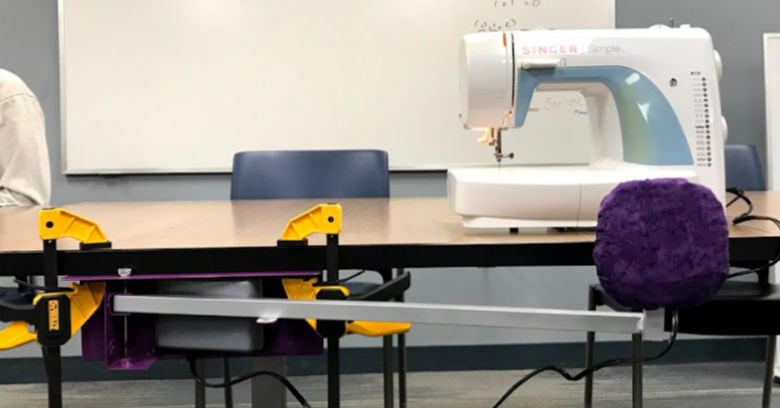
This project aims to adapt the Singer sewing machine of a woman with a spinal cord injury to enable her to use it without the foot pedal
Design Team Members: Melissa Ballasch, Brandon Kistler, Sarah Wojnarowski, Katie Hoenie
Faculty Advisor: Dr. Hongyan Zhang Client Advisor: the Ability Center of Greater Toledo
Project Sponsor: Wacker
Special Thanks to Dr. Zhang, John Jaegly, Tim Grivanos, Terry Kahle
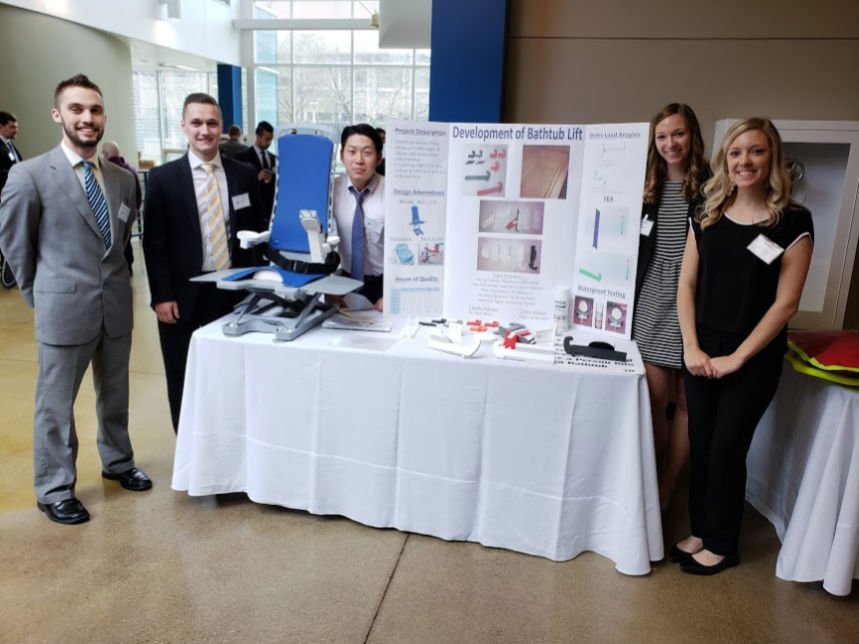
The purpose of this project is to give an individual with a severe form of Cerebral Palsy independence. Cerebral Palsy is a condition that affects body movement and muscle coordination. A very small and limited range of motion gives him minimal ability to perform any day-to-day tasks. Because he can’t do many of these everyday activities, his caregiver is responsible for helping him. As both the client and the caregiver grow older, it is becoming more and more strenuous on them both, especially for the caregiver. This project was designed to help the client safely gain independence during relaxation in the bathtub, while also giving the caregiver a break. Currently, his mother lowers him into the tub, holds him in a secure position while washing him in the bathtub, then lifts him out of the tub. A waterproof device with lowering/lifting capabilities and that gives peace of mind knowing he is secure in the bathtub is greatly desired for this specific situation. The device is required to lift 80 pounds, waterproof to prevent electrocution, hygienic to prevent mold growth, safe, and comfortable.
Design Team: Mackenzie Michalski, Jaclyn Melvin, Seokhwan Ji, Anthony Beier, Jonathan Krabill
Faculty Advisor: Dr. Reza Rizvi; Client Advisor: Angie Goodnight and the Ability Center of Greater Toledo; Project Sponsor: Wacker
Special Thanks to Dr. Reza Rizvi, University of Toledo, Dr. Lesley Berhan, University of Toledo, College of Engineering Machine shop: John Jaegly, University of Toledo Maker Space
The objective of this project is to design, analyze, construct, and test a device
to assist with the client, who has unfortunately 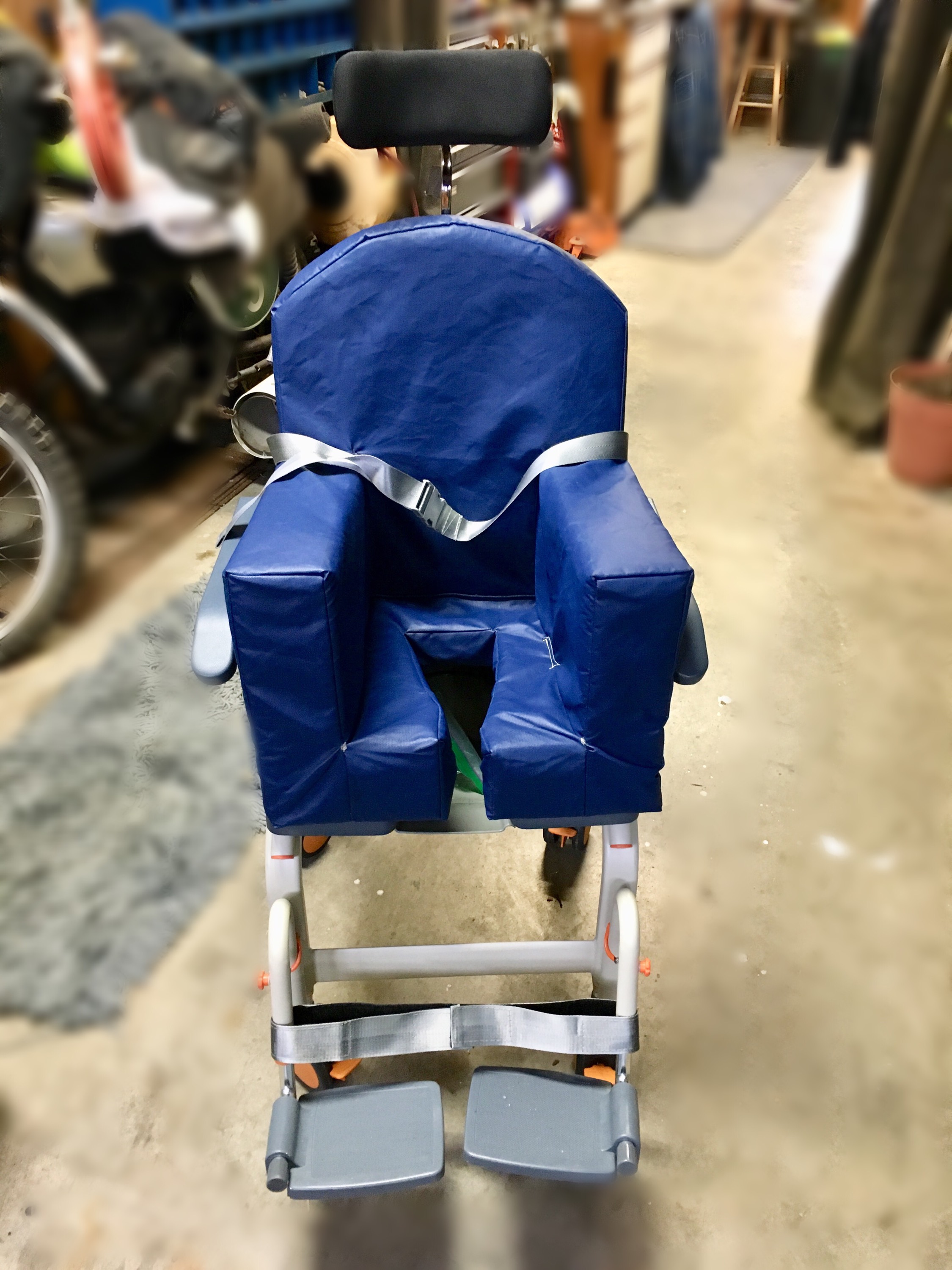 been affected by cerebral palsy, in using the toilet by himself without the assistance
of another human being. The main idea is that he would like some privacy when it comes
down to using the bathroom by himself. The device must be sturdy enough to support
at least 85 pounds, have a backrest with cushions, a seatbelt around the waist, footrest,
handrails to support the client, wheels and brakes, and have the ability to be out
of the way for other family members when they need to use the restroom also. This
device will help assist in using the restroom safely and properly while giving the
client the privacy that he deserves.
been affected by cerebral palsy, in using the toilet by himself without the assistance
of another human being. The main idea is that he would like some privacy when it comes
down to using the bathroom by himself. The device must be sturdy enough to support
at least 85 pounds, have a backrest with cushions, a seatbelt around the waist, footrest,
handrails to support the client, wheels and brakes, and have the ability to be out
of the way for other family members when they need to use the restroom also. This
device will help assist in using the restroom safely and properly while giving the
client the privacy that he deserves.
Design Team: Nicolette Hersch, Hadi Mohammed, Graham Goupille, Olivia Anders
Faculty Advisor: Dr. Reza Rizvi, Client Advisor: Angie Goodnight and the Ability Center of Greater Toledo
Project Sponsor: Wacker, Rand Industrial, The Ability Center of Greater Toledo
Special Thanks: We would like to give a special thanks to Dr. Reza Rizvi for being our faculty advisor and helping us throughout the semester with our project. We would also like to thank Rand Industrial Insulation for the kind donation towards our budget and supplying materials and labor to help complete the project.
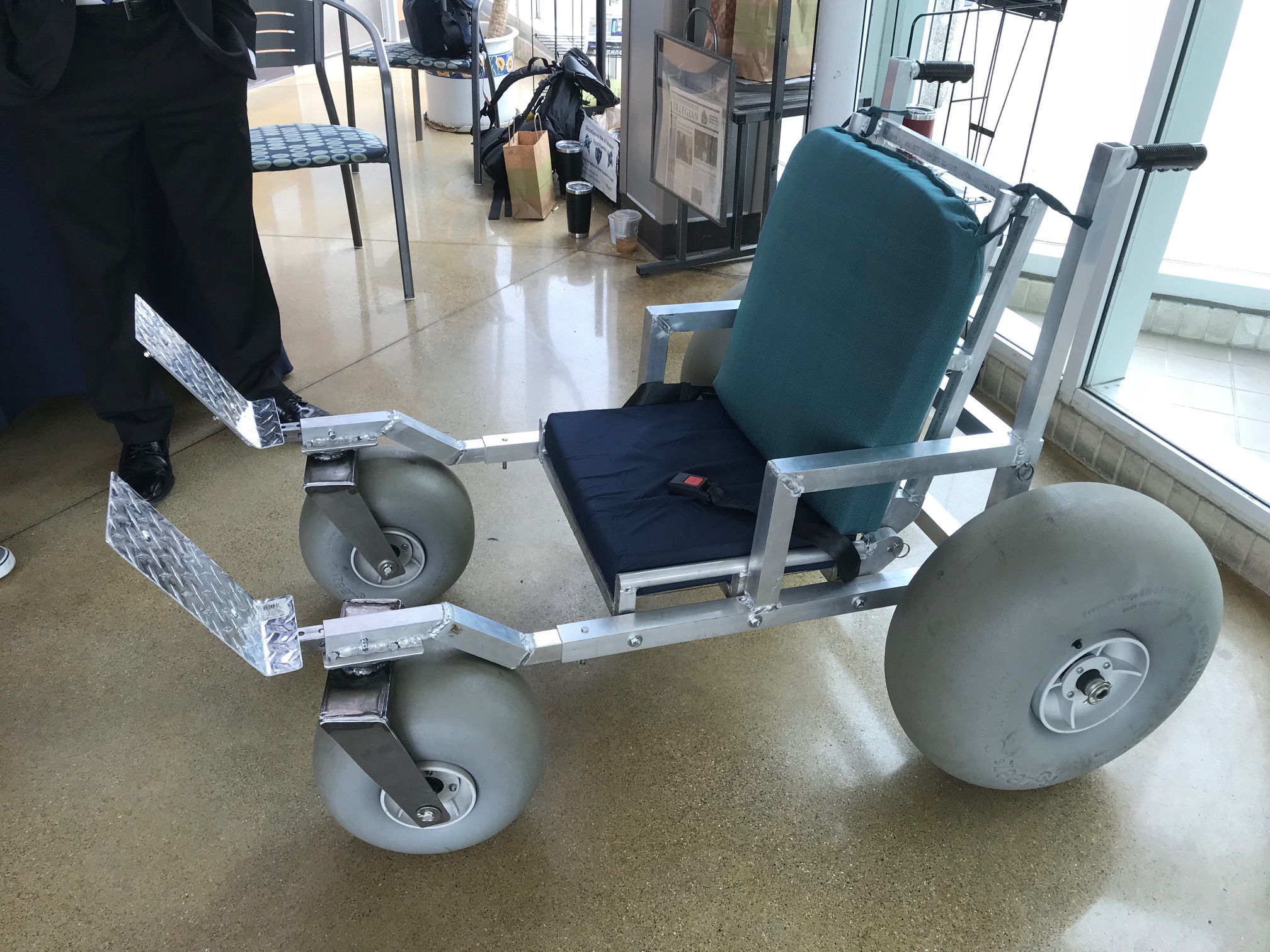 The Ability Center of Greater Toledo was in need of a new wheelchair for beach use.
This chair will be available for use by anyone in need of using it. We designed the
chair for stability, safety, and ease of use while keeping it transportable. We were
able to improve on our design thanks to extra support and donations. We were all happy
to be a part of a little something that has the potential to give a higher quality
of life to its users.
The Ability Center of Greater Toledo was in need of a new wheelchair for beach use.
This chair will be available for use by anyone in need of using it. We designed the
chair for stability, safety, and ease of use while keeping it transportable. We were
able to improve on our design thanks to extra support and donations. We were all happy
to be a part of a little something that has the potential to give a higher quality
of life to its users.
Design Team: Patrick Delaney, William Lopez, Tammy Reynolds, Aaron Slabic
Faculty Advisor: Dr. Hongyan Zhang, Client Advisor: Angie Goodnight and the Ability Center of Greater Toledo
Project Sponsor: Wacker, The Ability Center of Greater Toledo
Special Thanks: The team so greatly appreciates the generosity of Barb and Yolanda Cousino, Joel Groover, and Susan Knox along with the anonymous donations given to help make this project come to life.
Design Team: Scott Sampson, Mitchell Minnch, Quinn Welly, Surabhi Bhagavatula
Faculty/Client Advisor: Dr. Ray Hixon; Project Sponsor: The University of Toledo, MIME Department
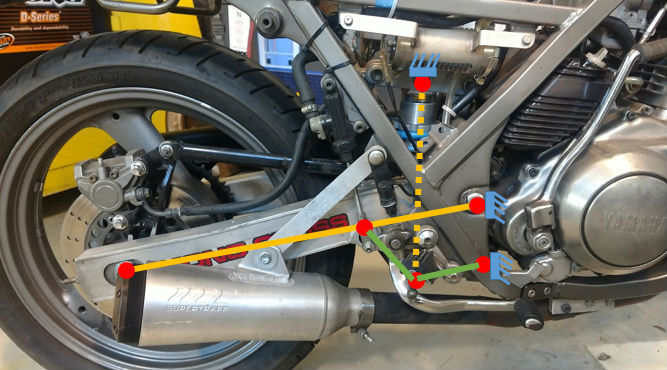 The client and advisor, Dr. Hixon, is an avid motorcyclist and super single class
racer and purchased this motorcycle approximately a year ago. When the bike was purchased
it was in a heavily modified state. Compared to the stock rear dual shock swing arm,
the rear suspension of this Yamaha SRX 600 has been swapped out, and the frame has
been adapted to a Yamaha SRX 400 swingarm, which mounts to a Rising Rate Linkage,
and a custom-made single motocross monotube spring-damper unit.
The client and advisor, Dr. Hixon, is an avid motorcyclist and super single class
racer and purchased this motorcycle approximately a year ago. When the bike was purchased
it was in a heavily modified state. Compared to the stock rear dual shock swing arm,
the rear suspension of this Yamaha SRX 600 has been swapped out, and the frame has
been adapted to a Yamaha SRX 400 swingarm, which mounts to a Rising Rate Linkage,
and a custom-made single motocross monotube spring-damper unit.
After a test run of the Motorcycle, Dr. Hixon felt unsatisfied with the performance of the rear suspension. The initial interpretation from Dr. Hixton’s test run is that the monoshock was very low in damping force, and then the damping force would suddenly increase part way through the stroke. Dr. Hixon wishes to use this bike as both a street bike and for use on a racetrack but does not intend to use this bike competitively. The initial task of this project is to evaluate the root cause of the sudden rise in damping and to evaluate if there is a single cause, or if there is a collective cause somewhere between the spring-damper unit and the suspension linkage itself.
Design Team: Matthew Long, Jason Schwind, Jonah Taylor, Drew Toth
Faculty/Client Advisor: Dr. Ray Hixon Project Sponsor: Dr. Ray Hixon
Sp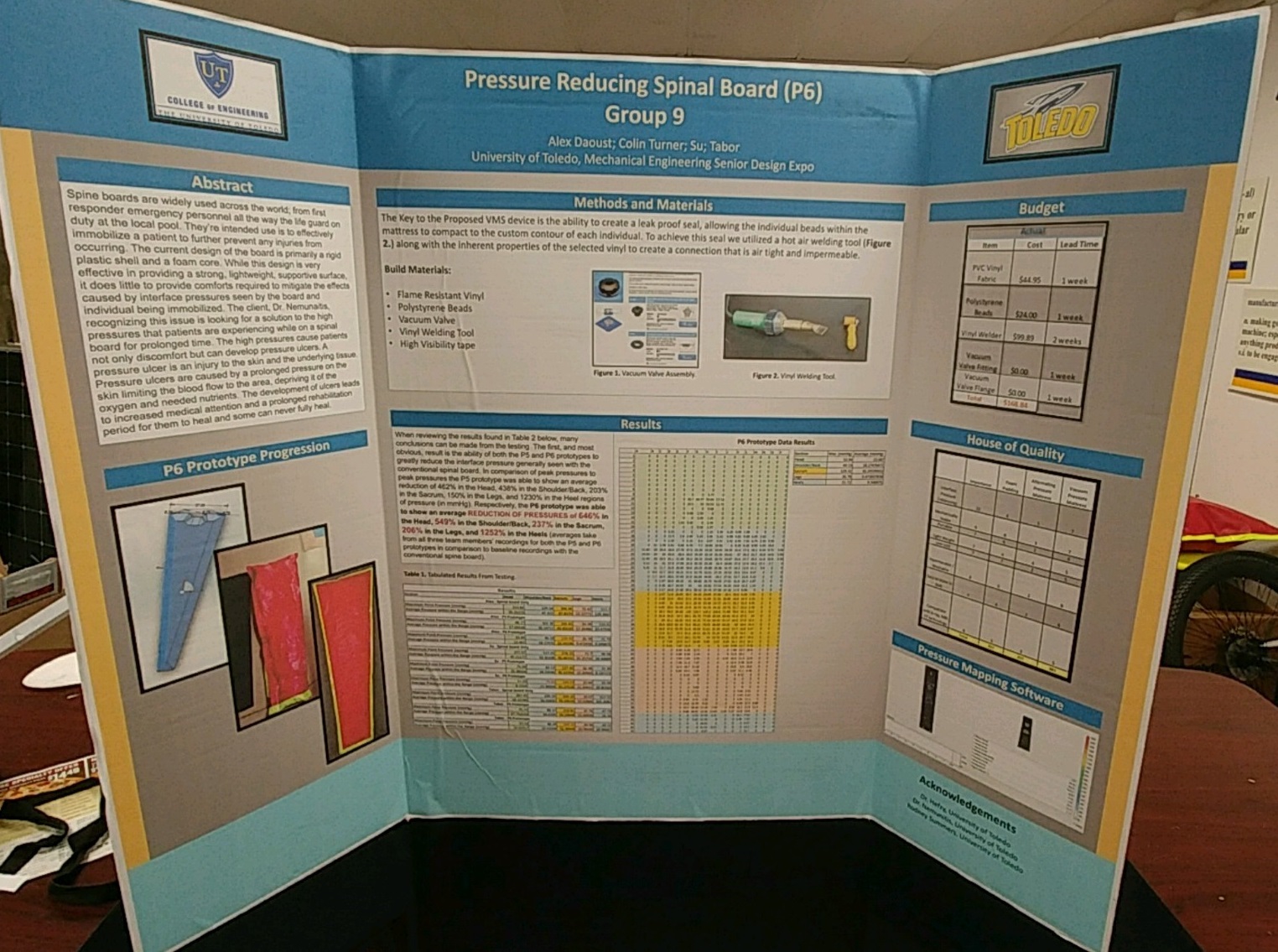 ine boards are widely used across the world; from first responder emergency personnel
all the way the life guard on duty at the local pool. They’re intended use is to effectively
immobilize a patient to further prevent any injuries from occurring. The current design
of the board is primarily a rigid HDPE shell with a foam core. While this design is
effective in providing a strong, lightweight, and supportive surface, it does little
to reduce interface pressures generated on the skin over boney contacts with the spine
board. The client, Dr. Nemunaitis, recognizing this issue is looking for a solution
to the high pressures when individuals are strapped to the spine board. The high pressures
cause patients not only discomfort but can develop pressure injury to the tissues
below. Pressure injury is caused by a prolonged pressure to the blood vessels limiting
the blood flow and causing tissue damage. The development of pressure injury leads
to increased cost, medical attention and a prolonged immobilization for proper treatment.
ine boards are widely used across the world; from first responder emergency personnel
all the way the life guard on duty at the local pool. They’re intended use is to effectively
immobilize a patient to further prevent any injuries from occurring. The current design
of the board is primarily a rigid HDPE shell with a foam core. While this design is
effective in providing a strong, lightweight, and supportive surface, it does little
to reduce interface pressures generated on the skin over boney contacts with the spine
board. The client, Dr. Nemunaitis, recognizing this issue is looking for a solution
to the high pressures when individuals are strapped to the spine board. The high pressures
cause patients not only discomfort but can develop pressure injury to the tissues
below. Pressure injury is caused by a prolonged pressure to the blood vessels limiting
the blood flow and causing tissue damage. The development of pressure injury leads
to increased cost, medical attention and a prolonged immobilization for proper treatment.
The proposed design that we felt best suited all of the needs encapsulated within this project came from the inspiration of a vacuum sealed mattress. This design utilizes technologies currently in use within the medical and emergency first responder fields alike and has shown a real promise in reducing interference pressures. Our design is comprised of vinyl sheeting fused together; the mattress is filled with individual polystyrene beads, and trough the implication of a one-way vacuum fitting it allows an individual to draw a vacuum and remove the remaining air from the mattress. The benefit of this design allows the mattress to be custom fit to each individual in question, maximizing the potential load distribution of each individual, theoretically resulting in lessening the peak pressure loads commonly seen in conventional spinal boards.
Design Team: Colin Turner, Alex Daoust, Caoannan Su, Tabor Mclaughlin
Faculty Advisor: Dr. Mohamed Samir Hefzy, Client Advisor: Dr. Greg Nemunaitis, Metro Health
Project Sponsor: The University of Toledo
Special Thanks: Rodney Summers, University of Toledo – Lab tech of the lab used for testing; Carmo, Supplier of injection molded plastic and PVC components
The objective of this project is to design, build, and analyze a wheelchair scale capable of weighing a wheelchair/person combination of up to 800 pounds. The clients for this scale are members of a support group at the Cleveland Clinic for people who are confined to wheelchairs, in this case, many of which are electric wheelchairs. The scale currently in use does not have a large enough platform or weight capacity to accommodate an electric wheelchair, which is much larger and heavier than a manual wheelchair. The proposed solution is to create a scale with a platform and load capacity to accommodate users who are in an electric wheelchair but will also be usable for manual wheelchairs. This design will be lightweight and easily moveable. This will allow the support group members to track their weight, providing invaluable information about their health.
Design Team: Gabe Hickman, Hanyoung Lim, Travis Siegel, John Gibson
Faculty Advisor: Dr. Mohamed Samir Hefzy, Client Advisor: Dr. Greg Nemunaitis
Project Sponsors: University of Toledo, Mosier Industrial Services, Premier Industrial Machine, Tacuna Systems
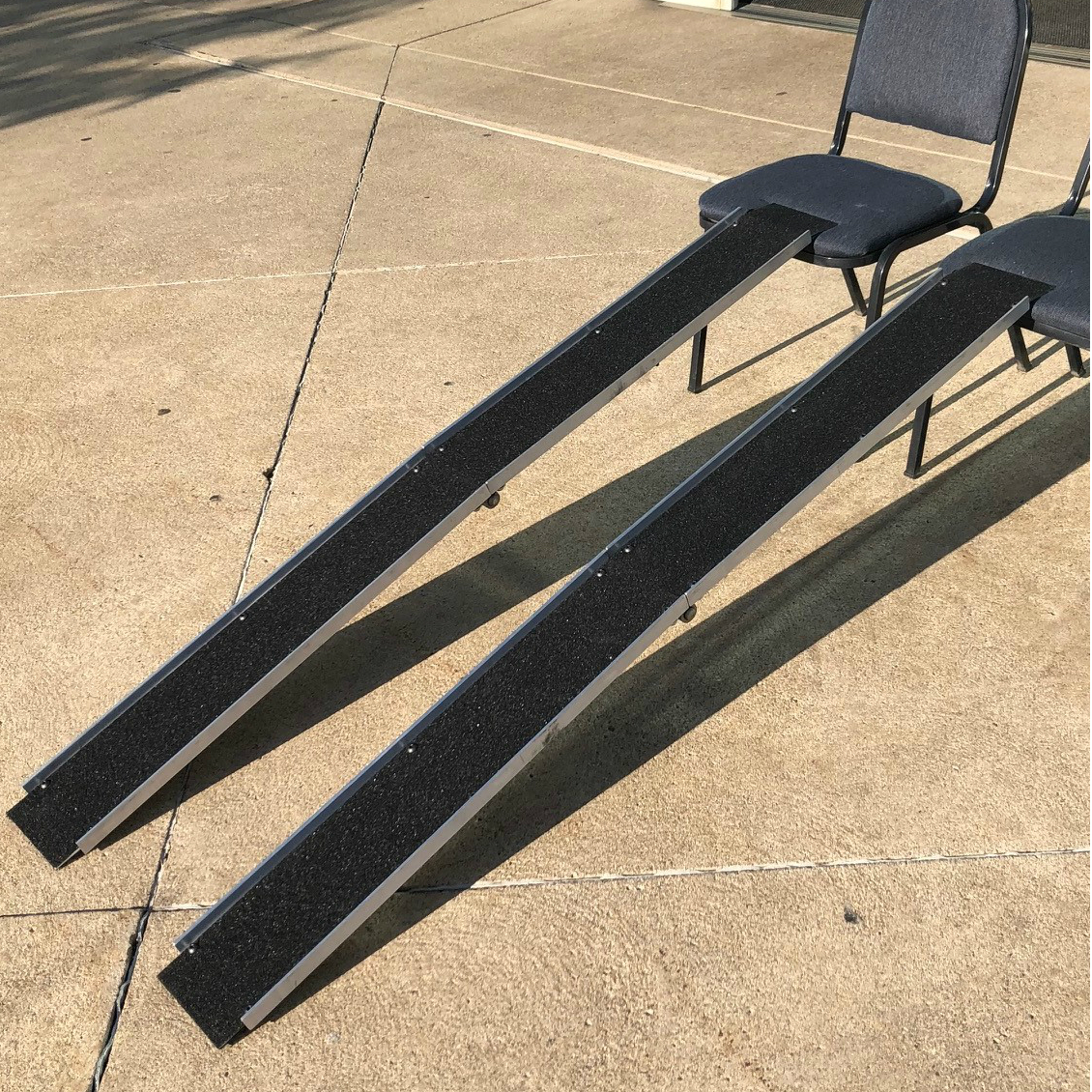 Our client lost the use of her legs in an accident and is wheelchair bound. She currently
uses a motorized wheelchair lift to enter and exit her home. During emergencies or
power outages she has to default to a wheelchair ramp since the lift is inoperable
without power. Her current ramp is heavy and bulky and cannot be operated by one person.
The goal of this project was to build a lightweight portable ramp to replace her current
ramp to enable her to enter and exit her home when the lift is without power. In addition,
the client would like the ramp to be universal in use so she can use the ramp to help
her gain access to houses and buildings with small two-step entrances and without
handicap entrances. This is an issue that she encounters when she goes to her parents’
or friends’ houses and she must be lifted over the steps in order to gain access.
Our client lost the use of her legs in an accident and is wheelchair bound. She currently
uses a motorized wheelchair lift to enter and exit her home. During emergencies or
power outages she has to default to a wheelchair ramp since the lift is inoperable
without power. Her current ramp is heavy and bulky and cannot be operated by one person.
The goal of this project was to build a lightweight portable ramp to replace her current
ramp to enable her to enter and exit her home when the lift is without power. In addition,
the client would like the ramp to be universal in use so she can use the ramp to help
her gain access to houses and buildings with small two-step entrances and without
handicap entrances. This is an issue that she encounters when she goes to her parents’
or friends’ houses and she must be lifted over the steps in order to gain access.
Design Team Members: Kyle Robbing - Team Lead; Andrew Schafer - Technical Liaison; Jakob Bohland - Purchasing Agent; Clinton Caddell - Communications Lead
Faculty/Client Advisor: Dr. Mohamed Hefzy - Facility Advisor; Dr. Greg Nemunaitis - Client Advisor
Project Sponsor: MetroHealth
Special Thanks: Dr. Mohamed Hefzy, Dr. Greg Nemunaitis, Dr. Brian Trease, John Jaegly
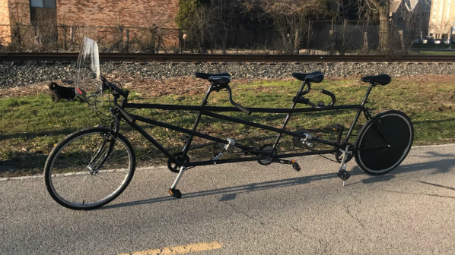 The goal of this project is to go fast, using multiple-people. A previous group designed
a three-person, tandem-style vehicle, and with some gearing modifications, traveled
32 mph. A subsequent group made some aerodynamic modifications and traveled at 36
mph. This semester, the goal is to go faster (safely) by: adding a larger front fairing,
evaluating and improving the brakes as needed, and finishing implementation of a system
that doesn't require all riders to pedal at the same time (like most tandems do).
The goal of this project is to go fast, using multiple-people. A previous group designed
a three-person, tandem-style vehicle, and with some gearing modifications, traveled
32 mph. A subsequent group made some aerodynamic modifications and traveled at 36
mph. This semester, the goal is to go faster (safely) by: adding a larger front fairing,
evaluating and improving the brakes as needed, and finishing implementation of a system
that doesn't require all riders to pedal at the same time (like most tandems do).
Design Team Members: Bradley Boss, Corey Tipton, Peter Duchini, Logan Davies
Faculty/Client Advisor: Adam Schroeder, Dr. Brian Trease
Sponsor: University of Toledo MIME Department
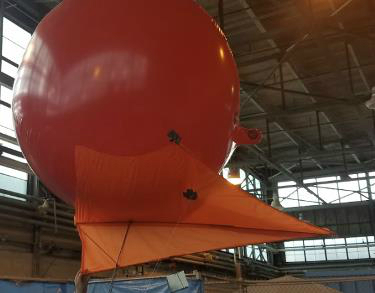 In the past few years Lake Erie has had an increase in algae growth. This growth
limits the amount of oxygen in the water creating dead zones where no aquatic life
can survive. This alga can also make the water unsafe to consume due to a toxin it
produces called microcystin. In hopes of finding a solution to these problems, researchers
must be able to understand how the algae grow, move and where the algae are most highly
concentrated. One way to do this is to take photos during the months in which the
growth is high. There are currently two methods to do this, aircraft and satellites.
Aircraft are expensive to rent and are hindered by inclement weather. Satellites
are limited in the resolution of their pictures since they are so far from the surface.
Our proposed solution is to create a stable aerostat that will fly at about 500 feet
and be able to be left to fly for extended periods of time allowing for greater detail
in the pictures and a longer span of time for more photos and the ability for a time-lapse.
In the past few years Lake Erie has had an increase in algae growth. This growth
limits the amount of oxygen in the water creating dead zones where no aquatic life
can survive. This alga can also make the water unsafe to consume due to a toxin it
produces called microcystin. In hopes of finding a solution to these problems, researchers
must be able to understand how the algae grow, move and where the algae are most highly
concentrated. One way to do this is to take photos during the months in which the
growth is high. There are currently two methods to do this, aircraft and satellites.
Aircraft are expensive to rent and are hindered by inclement weather. Satellites
are limited in the resolution of their pictures since they are so far from the surface.
Our proposed solution is to create a stable aerostat that will fly at about 500 feet
and be able to be left to fly for extended periods of time allowing for greater detail
in the pictures and a longer span of time for more photos and the ability for a time-lapse.
Design Team Members: Kyle Gladieux, Bryan Carolin, Logan Swanger
Faculty/Client Advisor: Dr. Brian Trease, Adam Schroeder
Project Sponsor: Dr. Brian Trease
Special Thanks to Adam Schroeder for Advice & Feedback; Brian Trease for Lab Space & Project Funding; John Jaegly for Assistance With Lab Testing; Patrick Shemenski for help with the 3D Printed Parts; and finally Lucas Palumbo for Electronics
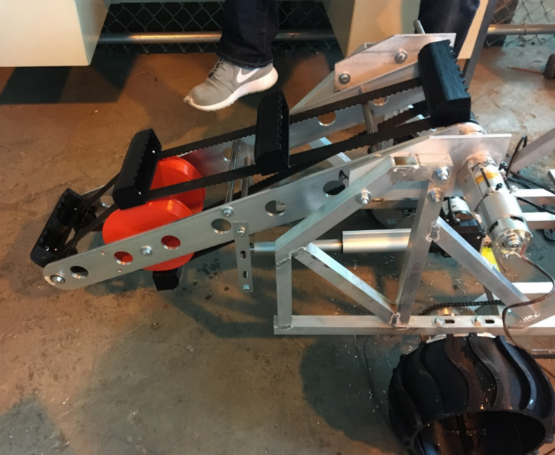 NASA hosts an annual university competition to create and pilot a Mars mining robot.
This is our first time participating in the event, and we have already received $5000
in support from the Ohio Space Grant Consortium. A Senior Design Team initiated the
project last semester, completing many elements of the structure and mobility system.
The current design team worked to complete and test the robot.
NASA hosts an annual university competition to create and pilot a Mars mining robot.
This is our first time participating in the event, and we have already received $5000
in support from the Ohio Space Grant Consortium. A Senior Design Team initiated the
project last semester, completing many elements of the structure and mobility system.
The current design team worked to complete and test the robot.
Teams have 10 minutes to navigate a course representing Martian surface conditions. The goal during is to collect as much gravel (which simulates icy regolith) from below the surface of a silty terrain. The gravel must then be transferred back to a collection bucket; points are awarded for the amount collected. Points are also deducted based on robot weight, energy usage, and wireless bandwidth usage. The robot must be under 80 kg and fit within a 1.5 x 0.75 x 0.75 m volume.
Design Team Members: James Sabatka- Team Leader; Elisabeth Emane- Technical Liaison; Patrick Luettke- Purchasing Agent; Justin Soncrant – Web Page Specialist
Faculty/Client Advisor: Professor Brian Trease
Project Sponsor: University of Toledo
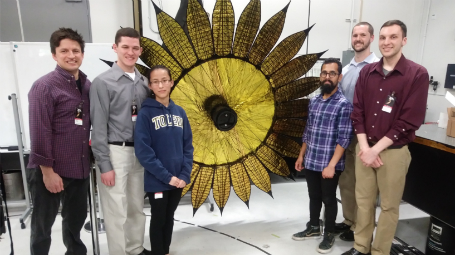 The current NASA Starshade optical shield cannot support its own weight under Earth’s
gravity. It is supported with a counterbalance system which utilizes wires, pulleys,
and counterweights. The purpose of this project is to design a wrapped-rib structure
for the Starshade optical shield that can easily be integrated into the current design.
The newly integrated ribs will provide support to the blanket in order to prevent
drooping.
The current NASA Starshade optical shield cannot support its own weight under Earth’s
gravity. It is supported with a counterbalance system which utilizes wires, pulleys,
and counterweights. The purpose of this project is to design a wrapped-rib structure
for the Starshade optical shield that can easily be integrated into the current design.
The newly integrated ribs will provide support to the blanket in order to prevent
drooping.
Design Team Members: Alexander Binder, Mark Gore, Nai-Ning Kuo, Steven Will
Faculty/Client Advisor: Dr. Brian Trease - Faculty Advisor; Dr. Manan Arya - Client Advisor
Project Sponsor: UT MIME Department Senior Design Program; JPL Center for Academic Partnership
Special Thanks: Dr. Brian Trease, Dr. Manan Arya
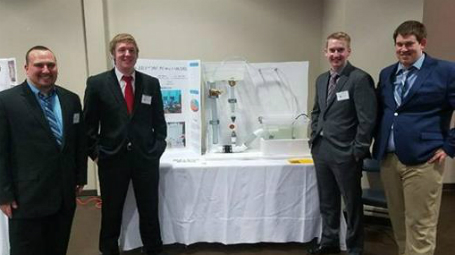 The goal of this project is to model and analyze a novel technology related to hydro
power.
The goal of this project is to model and analyze a novel technology related to hydro
power.
Design Team Members: Alex Zaleski, Alex Meier, Jon Reisig, David Martinek
Faculty Advisor: Dr. Sorin Cioc; Client Advisor: Mark Anteau
Project Sponsor: Mark Anteau
Special Thanks: Dr. Sorin Cioc, Mark Anteau, The University of Toledo, The UT College of Engineering, Patrick Shemenski, The Reisig Family
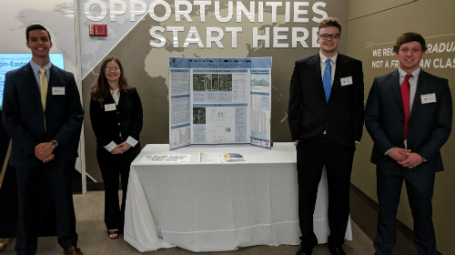 The purpose of our project is to permit, design, and estimate a solar array project
for the University of Toledo. Our client is Michael Green, the director of energy
management for the University of Toledo, who has allowed us to take over the project
that he had begun. Dr. Randy Ellingson is our advisor and student Jason Gonring will
be assisting in the design process. First Solar donated over 1,000 solar panels to
the University to be used however we wish.
The purpose of our project is to permit, design, and estimate a solar array project
for the University of Toledo. Our client is Michael Green, the director of energy
management for the University of Toledo, who has allowed us to take over the project
that he had begun. Dr. Randy Ellingson is our advisor and student Jason Gonring will
be assisting in the design process. First Solar donated over 1,000 solar panels to
the University to be used however we wish.
Our group has the main tasks of deciding the location for the panels, designing the layout of the array, working with a racking and inverter supplier, providing the necessary construction documents, and estimating the cost of the project. The end goal is to have the entire project planned out by the end of the semester, and have it approved by the Vice President of Facilities and Construction so that the project can begin construction by the beginning of summer 2018.
Design Team Members: Alex Demory, Matthew Snyder, Samantha Hunt, Jacob Smith
Faculty/Client Advisor: Dr. Randall Ellingson, Jason Gorning, Michael Green
Special Thanks: First Solar, UT Student Green Fund, University of Toledo Facilities and Operations, Dr. Randy Ellingson, Michael Green and Jason Gonring
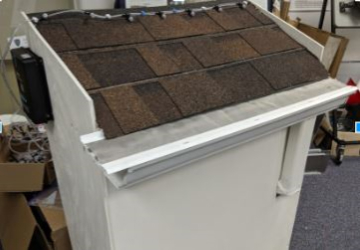 When below freezing temperatures combine with snow accumulation on the roof and the
house temperatures that melt snow on the majority of the roof, the melted snow refreezes
near the gutter causing potentially damaging ice damming. We are proposing a system
that will spray de-icing fluid on the roof and gutter to prevent ice damming.
When below freezing temperatures combine with snow accumulation on the roof and the
house temperatures that melt snow on the majority of the roof, the melted snow refreezes
near the gutter causing potentially damaging ice damming. We are proposing a system
that will spray de-icing fluid on the roof and gutter to prevent ice damming.
Design Team Members: Samantha Perry, Evan Pelton, Alex Medley, Ryan Czajka, Nick Wilson, Javier Salazar, Jacob Strohscher
Faculty Advisor: Dr. Sorin Cioc
Project Sponsor: Tony Jiannuzzi
Special Thanks: Leaf Filter
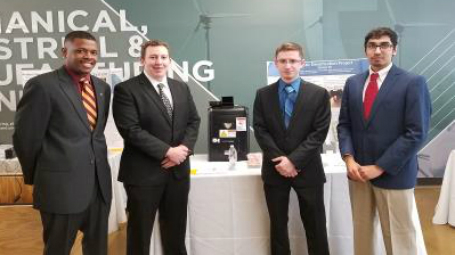 The objective of this project is to design, analyze, build and test a device that
will help reduce the amount of plastic that escapes into the environment every year.
The client is currently a strong advocate for the reduction of pollution into the
environment and recycling, these two factors combined produced the idea of a plastic
densification machine to help eliminate point source emissions and increase consumer
participation. The proposed solution is to design a working system with two main sections.
The first section is a size reduction mechanism primarily an industrial shredder to
decrease the plastics to the size of confetti. The second section involves a heated
funnel to a plastic mold in order to produce plastic blocks. This will not only reduce
the amount of plastics that are able to enter into the environment, but will also
open up the opportunity for aid groups and developing nations to use these blocks
as cheap building materials in cases of refugee camps, disaster relief, and other
cases of short term living and development. The prospects for this technology can
eventually branch into other industries and help reduce plastic waste in the environment
by turning it into a useful product.
The objective of this project is to design, analyze, build and test a device that
will help reduce the amount of plastic that escapes into the environment every year.
The client is currently a strong advocate for the reduction of pollution into the
environment and recycling, these two factors combined produced the idea of a plastic
densification machine to help eliminate point source emissions and increase consumer
participation. The proposed solution is to design a working system with two main sections.
The first section is a size reduction mechanism primarily an industrial shredder to
decrease the plastics to the size of confetti. The second section involves a heated
funnel to a plastic mold in order to produce plastic blocks. This will not only reduce
the amount of plastics that are able to enter into the environment, but will also
open up the opportunity for aid groups and developing nations to use these blocks
as cheap building materials in cases of refugee camps, disaster relief, and other
cases of short term living and development. The prospects for this technology can
eventually branch into other industries and help reduce plastic waste in the environment
by turning it into a useful product.
Design Team Members: Brandon Brown, Govind Giri, Jeremy Scott, Christopher Solly
Faculty/Client Advisor: Dr. Hossein Sojoudi
Project Sponsor: Mr. Scott Steele
Special Thanks: The University of Toledo Maker Space Society, Dr. Hossein Sojoudi, Mr. Scott Steele
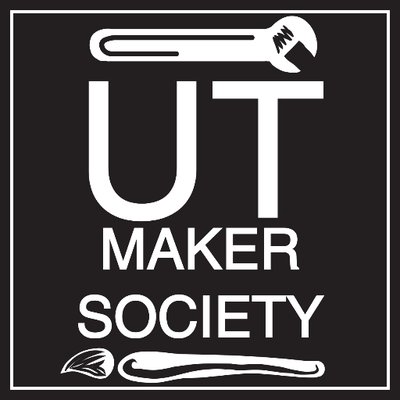 The objective of this project is to design a space for the University of Toledo’s
students to be the center of self-initiated design and innovation that supports all
students, design courses, and student groups. Availability, flexibility and community
are the main concerns when considering the design of the space. The College of Engineering
wants the space to be available at a variety of times to best accommodate the students'
schedules. A wide range of machines, tools, technology and resources will make the
space flexible to help students with all of their needs. Location of the space will
have a supportive atmosphere being surrounded by computer labs, dining options, classrooms,
other students and faculty.
The objective of this project is to design a space for the University of Toledo’s
students to be the center of self-initiated design and innovation that supports all
students, design courses, and student groups. Availability, flexibility and community
are the main concerns when considering the design of the space. The College of Engineering
wants the space to be available at a variety of times to best accommodate the students'
schedules. A wide range of machines, tools, technology and resources will make the
space flexible to help students with all of their needs. Location of the space will
have a supportive atmosphere being surrounded by computer labs, dining options, classrooms,
other students and faculty.
Design Team Members: Bradley Mullins, Jessica Ostrowski, Elijah Owens, Timothy Schleicher, Benjamin Szirony, Nikota Voigt
Faculty/Client Advisor: Dr. Matthew Franchetti
Project Sponsor: Hotmer Family
Special Thanks: Dr. Matthew Franchetti, The Hotmer Family, The University of Toledo, The College of Engineering, The UT Maker Society, The BiG Fab Lab
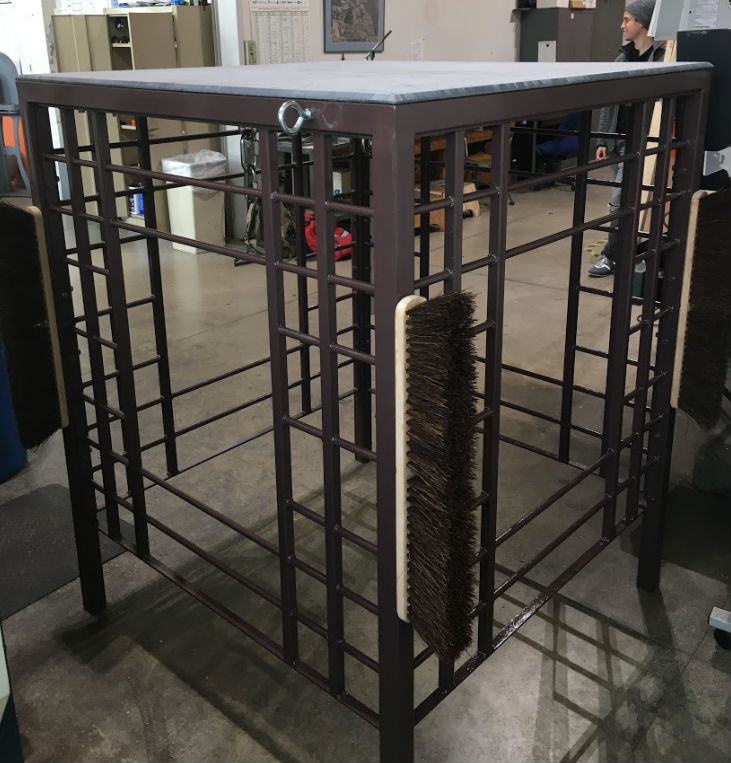 The wolves at The Toledo Zoo are very active and highly intelligent creatures. Our
goal as a senior design group is to design an interactive way to feed and entertain
the wolves. Our client would like for our group to design a standing platform that
challenges the wolves to be creative and work together. The exhibit contains three
brother wolves, Lobo, Loki, and Tundra. The wolves are 4 years old and highly intelligent.
They are very destructive and will find a way to destroy nearly anything.
The wolves at The Toledo Zoo are very active and highly intelligent creatures. Our
goal as a senior design group is to design an interactive way to feed and entertain
the wolves. Our client would like for our group to design a standing platform that
challenges the wolves to be creative and work together. The exhibit contains three
brother wolves, Lobo, Loki, and Tundra. The wolves are 4 years old and highly intelligent.
They are very destructive and will find a way to destroy nearly anything.
Currently, these wolves are occupied by a variety of treats and toys. They like grapevine wreaths filled with cat food or other treats; these are good because they force the wolves to work to get their reward. They also are given ribs, pig ears, meat/hide burritos and bones to help keep them occupied. They receive 4 of these items per day, but only one bone per day. They also have some durable balls with holes that can dispense treats or scents that the wolves like to play with. They also have some deck brushes that the zookeepers coat in scents, which the wolves like to rub against for the scent and also to scratch themselves and remove their winter coats. The problem with all of these distractions is that they are short term and the wolves will finish them or get bored of them within a few hours.
The puzzle-platform is a design that is able to be loaded heavily with sticks with limitless variations and challenges built by the zookeepers. The larger the stick puzzle, the more time the wolves will expand in solving the puzzle and reaching the reward hidden in the middle. A variation of this design was first implemented by the Dartmoor Zoo for the lioness exhibit. The puzzle-platform for this project is different because it will serve as a den and perch for the wolves in addition to creating a challenging activity
Design Team Members: Justin Stevenor, Brian LaFreniere, Matthew Allard, Luke Hall
Faculty/Client Advisor: Dr. Lesley Berhan
Project Sponsor: Beth Posta, Toledo Zoo
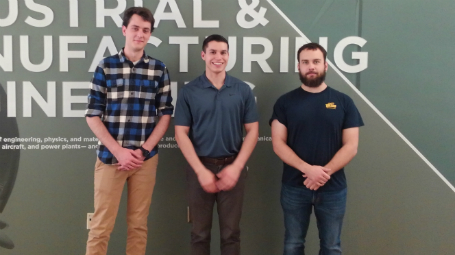 The objective of this project was to design, manufacture, and deliver a new data acquisition
system for the University of Toledo Formula SAE team. This system will facilitate
the collection of race data in order to better design, tune and validate the suspension
system of the Formula car. Our goal was to be able to measure pushrod strain, damper
position, wheel speed, and brake rotor temperature for all four corners as well as
steering angle, brake pressure and acceleration in three axes about the center of
gravity. The construction of the wiring harness must be clean and robust to endure
the rigors of racing and the scrutiny of design judges at competition.
The objective of this project was to design, manufacture, and deliver a new data acquisition
system for the University of Toledo Formula SAE team. This system will facilitate
the collection of race data in order to better design, tune and validate the suspension
system of the Formula car. Our goal was to be able to measure pushrod strain, damper
position, wheel speed, and brake rotor temperature for all four corners as well as
steering angle, brake pressure and acceleration in three axes about the center of
gravity. The construction of the wiring harness must be clean and robust to endure
the rigors of racing and the scrutiny of design judges at competition.
Design Team Members: Derek Denti, Cody Mills, Ian Betz
Faculty Advisor: Dr. Ray Hixon; Client Advisor: Jacob Kennedy
Project Sponsor: University of Toledo Formula SAE
Special Thanks: Cherry Picked Auto Parts of Toledo, Ohio; Dr. Hixon; University of Toledo Formula SAE Team; Jacob Kennedy


